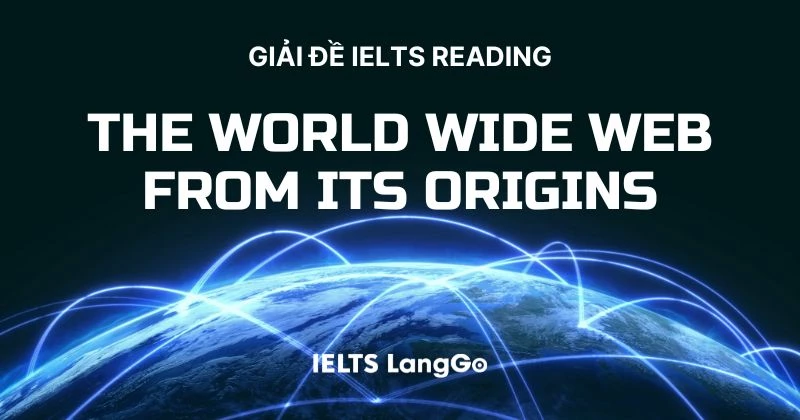



Việc luyện đề IELTS Reading thường xuyên không chỉ giúp bạn nâng cao kỹ năng làm bài mà còn giúp bạn bổ sung vốn từ vựng theo chủ đề.
Trong bài viết này, chúng ta sẽ cùng giải đề Reading topic New media: The World Wide Web from its origins để luyện tập 3 dạng câu hỏi True/ False/ Not given, Note completion, Short answer question nhé.
The World Wide Web from its origins
'Information Management: A Proposal'. That was the bland title of a document written in March 1989 by a then little- known computer scientist called Tim Berners-Lee, who was working at CERN, Europe’s particle physics laboratory, near Geneva. His proposal, modestly called the World Wide Web, has achieved far more than anyone expected at the time. In fact, the Web was invented to deal with a specific problem. In the late 1980s, CERN was planning one of the most ambitious scientific projects ever, the Large Hadron Collider*, or LHC. As the first few lines of the original proposal put it, 'Many of the discussions of the future at CERN and the LHC end with the question "Yes, but how will we ever keep track of such a large project?" This proposal provides an answer to such questions. The Web, as everyone now knows, has many more uses than the original idea of linking electronic documents about particle physics in laboratories around the world. But among all the changes it has brought about, from personal social networks to political campaigning, it has also transformed the business of doing science itself, as the man who invented it hoped it would. It allows journals to be published online and links to be made from one paper to another. It also permits professional scientists to recruit thousands of amateurs to give them a hand. One project of this type, called GalaxyZoo, used these unpaid workers to classify one million images of galaxies into various types (spiral, elliptical and irregular). This project, which was intended to help astronomers understand how galaxies evolve, was so successful that a successor has now been launched, to classify the brightest quarter of a million of them in finer detail. People working for a more modest project called Herbaria@home examine scanned images of handwritten notes about old plants stored in British museums. This will allow them to track the changes in the distribution of species in response to climate change. Another new scientific application of the Web is to use it as an experimental laboratory. It is allowing social scientists, in particular, to do things that were previously impossible. In one project, scientists made observations about the sizes of human social networks using data from Facebook. A second investigation of these networks, produced by Bernardo Huberman of HP Labs, Hewlett-Packard's research arm in Pato Alto, California, looked at Twitter, a social networking website that allows people to post short messages to long lists of friends. At first glance, the networks seemed enormous - the 300,000 Twitterers sampled had 80 friends each, on average (those on Facebook had 120), but some listed up to 1,000. Closer statistical inspection, however, revealed that the majority of the messages were directed at a few specific friends. This showed that an individual's active social network is far smaller than his 'clan'. Dr Huberman has also helped uncover several laws of web surfing, including the number of times an average person will go from web page to web page on a given site before giving up, and the details of the 'winner takes all' phenomenon, whereby a few sites on a given subject attract most of the attention, and the rest get very little. Scientists have been good at using the Web to carry out research. However, they have not been so effective at employing the latest web-based social-networking tools to open up scientific discussion and encourage more effective collaboration. Journalists are now used to having their articles commented on by dozens of readers. Indeed, many bloggers develop and refine their essays as a result of these comments. Yet although people have tried to have scientific research reviewed in the same way, most researchers only accept reviews from a few anonymous experts. When Nature, one of the world's most respected scientific journals, experimented with open peer review in 2006, the results were disappointing. Only 5% of the authors it spoke to agreed to have their article posted for review on the Web - and their instinct turned out to be right, because almost half of the papers attracted no comments. Michael Nielsen, an expert on quantum computers, belongs to a new wave of scientist bloggers who want to change this. He thinks the reason for the lack of comments is that potential reviewers lack incentive. Adapted from The Economist * The Large Hadron Collider (LHC) is the world's largest particle accelerator and collides particle beams. It provides information on fundamental questions of physics. |
Questions 1-6
Do the following statements agree with the information given in the reading passage?
Write
TRUE if the statement agrees with the information
FALSE if the statement contradicts the information
NOT GIVEN if there is no information on this
1. ………… Tim Berners-Lee was famous for his research in physics before he invented the World Wide Web.
2. ………… The original intention of the Web was to help manage one extremely complex project.
3. ………… Tim Berners-Lee has also been active in politics.
4. ………… The Web has allowed professional and amateur scientists to work together.
5. ………… The second galaxy project aims to examine more galaxies than the first.
6. ………… Herbaria@home’s work will help to reduce the effects of climate change.
Questions 7-10
Complete the notes below.
Choose NO MORE THAN TWO WORDS from the passage for each answer.
Social networks and Internet use
Web used by Social scientists (including Dr Huberman) to investigate the 7………… of social networks.
Most 8………… intended for limited number of people - not everyone on list.
Dr Huberman has also investigated:
Questions 11-13
Answer the questions below.
Choose NO MORE THAN TWO WORDS from the passage for each answer.
11. Whose writing improves as a result of feedback received from readers? …………
12. What type of writing is not reviewed extensively on the Web? …………
13. Which publication invited authors to publish their articles on the World Wide Web? …………
Từ đề bài, các bạn có thể thấy, bài đọc gồm 13 câu hỏi chia thành 3 dạng bài bao gồm:
Trước khi đi vào làm đề, các bạn hãy lưu ý cách làm 3 dạng bài này nhé:
Lưu ý: Khi đưa ra lựa chọn đáp án, các bạn hãy nhớ xem xét 3 điều sau:
Xem thêm: Cách làm dạng bài True/False/Not Given IELTS chuẩn nhất
+ Đọc tiêu đề - title để biết thông tin chung mà ghi chú đề cập đến.
+ Hãy đọc kỹ cả câu để xem thông tin cần điền là gì. để ý các từ khóa xung quanh.
+ Tìm ra loại từ phù hợp cần điền vào chỗ trống.
+ Gạch chân các KEY WORDS trong ghi chú, chúng sẽ giúp chúng ta tìm được các thông tin trong bài đọc và trong các khoảng trống
Xem thêm: Hướng dẫn làm dạng Sentence completion IELTS Reading siêu nhanh gọn
Xem thêm: 5 bước chinh phục dạng bài Short answer questions IELTS Reading
Sau khi đã làm đề Reading một cách nghiêm túc, các bạn hãy kiểm tra xem mình đã làm đúng chưa nhé.

ĐÁP ÁN
FALSE
Giải thích: Đoạn 1 có câu “Information Management: A Proposal' [...] written in March 1989 by a then little-known computer scientist called Tim Berners-Lee” - cho thấy ông là một nhà khoa học máy tính ít được biết đến tại thời điểm đó. Điều này mâu thuẫn với ý cho rằng ông đã nổi tiếng trước khi phát minh ra Web.
TRUE
Giải thích: Đoạn 2 có câu "the Web was invented to deal with a specific problem. In the late 1980s, CERN was planning one of the most ambitious scientific projects ever, the Large Hadron Collider" - Web được tạo ra để giải quyết vấn đề quản lý dự án LHC phức tạp này.
NOT GIVEN
Giải thích: Đoạn 3 có đề cập đến "political campaigning" như một trong những thay đổi mà Web mang lại, nhưng không có thông tin nào về việc Tim Berners-Lee có tham gia hoạt động chính trị hay không.
TRUE
Giải thích: Đoạn 4 mô tả rõ việc các nhà khoa học chuyên nghiệp có thể "recruit thousands of amateurs to give them a hand", với ví dụ cụ thể là dự án GalaxyZoo, nơi những người không chuyên giúp phân loại hình ảnh thiên hà.
FALSE
Giải thích: Ở đoạn 4, dự án đầu tiên phân loại "one million images of galaxies", trong khi dự án tiếp theo chỉ nhằm phân loại "the brightest quarter of a million" - tức là ít hơn.
NOT GIVEN
Giải thích: Ở đoạn 4, dự án Herbaria@home được mô tả là "allow them to track the changes in the distribution of species in response to climate change" không hề đề cập đến việc liệu công việc này có giúp giảm tác động của biến đổi khí hậu hay không.
sizes
Câu dẫn chứng đoạn 5 "scientists made observations about the sizes of human social networks using data from Facebook".
messages
Câu dẫn chứng đoạn 6 “the majority of the messages were directed at a few specific friends".
web surfing
Câu dẫn chứng đoạn 6 "Dr. Huberman has also helped uncover several laws of web surfing"
attention
Câu dẫn chứng đoạn 6 “winner takes all' [...] whereby a few sites on a given subject attract most of the attention".
bloggers
Câu dẫn chứng đoạn 8: "many bloggers develop and refine their essays as a result of these comments".
scientific research
Câu dẫn chứng đoạn 8: "most researchers only accept reviews from a few anonymous experts".
nature
Câu dẫn chứng đoạn 8: "Nature, one of the world's most respected scientific journals, experimented with open peer review in 2006"
Trên đây, chúng ta đã cùng luyện Reading qua bài đọc The World Wide Web from its origins. Hy vọng rằng các hướng dẫn và lưu ý từ IELTS LangGo sẽ giúp bạn làm bài chính xác hơn và cải thiện kỹ năng của mình.



ĐẶT LỊCH TƯ VẤN MIỄN PHÍ LỘ TRÌNH Săn ƯU ĐÃI lên tới 12.000.000đ